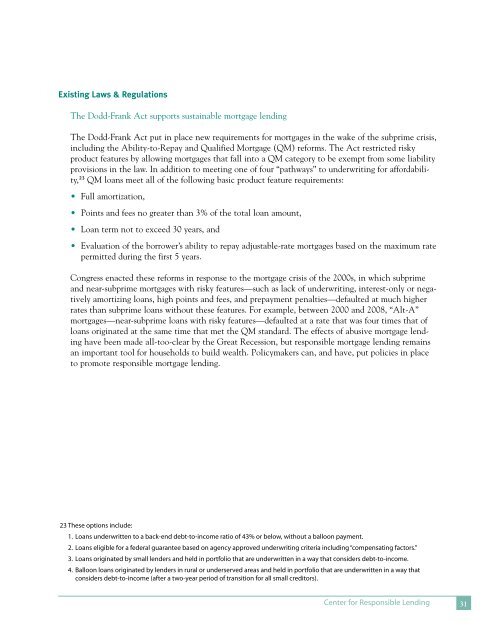You also want an ePaper? Increase the reach of your titles
YUMPU automatically turns print PDFs into web optimized ePapers that Google loves.
Existing Laws & Regulations<br />
<strong>The</strong> Dodd-Frank Act supports sustainable mortgage lending<br />
<strong>The</strong> Dodd-Frank Act put in place new requirements for mortgages in the wake <strong>of</strong> the subprime crisis,<br />
including the Ability-to-Repay and Qualified Mortgage (QM) reforms. <strong>The</strong> Act restricted risky<br />
product features by allowing mortgages that fall into a QM category to be exempt from some liability<br />
provisions in the law. In addition to meeting one <strong>of</strong> four “pathways” to underwriting for affordability,23<br />
QM loans meet all <strong>of</strong> the following basic product feature requirements:<br />
• Full amortization,<br />
• Points and fees no greater than 3% <strong>of</strong> the total loan amount,<br />
• Loan term not to exceed 30 years, and<br />
• Evaluation <strong>of</strong> the borrower’s ability to repay adjustable-rate mortgages based on the maximum rate<br />
permitted during the first 5 years.<br />
Congress enacted these reforms in response to the mortgage crisis <strong>of</strong> the 2000s, in which subprime<br />
and near-subprime mortgages with risky features—such as lack <strong>of</strong> underwriting, interest-only or negatively<br />
amortizing loans, high points and fees, and prepayment penalties—defaulted at much higher<br />
rates than subprime loans without these features. For example, between 2000 and 2008, “Alt-A”<br />
mortgages—near-subprime loans with risky features—defaulted at a rate that was four times that <strong>of</strong><br />
loans originated at the same time that met the QM standard. <strong>The</strong> effects <strong>of</strong> abusive mortgage lending<br />
have been made all-too-clear by the Great Recession, but responsible mortgage lending remains<br />
an important tool for households to build wealth. Policymakers can, and have, put policies in place<br />
to promote responsible mortgage lending.<br />
23 <strong>The</strong>se options include:<br />
1. Loans underwritten to a back-end debt-to-income ratio <strong>of</strong> 43% or below, without a balloon payment.<br />
2. Loans eligible for a federal guarantee based on agency approved underwriting criteria including “compensating factors.”<br />
3. Loans originated by small lenders and held in portfolio that are underwritten in a way that considers debt-to-income.<br />
4. Balloon loans originated by lenders in rural or underserved areas and held in portfolio that are underwritten in a way that<br />
considers debt-to-income (after a two-year period <strong>of</strong> transition for all small creditors).<br />
Center for Responsible Lending 31


